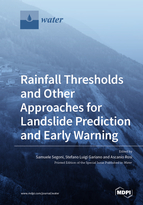Rainfall Thresholds and Other Approaches for Landslide Prediction and Early Warning
A special issue of Water (ISSN 2073-4441). This special issue belongs to the section "Hydrology".
Deadline for manuscript submissions: closed (31 July 2020) | Viewed by 60197
Special Issue Editors
Interests: prediction and mapping of landslide hazards; physically based models for the triggering of shallow landslides; landslide susceptibility maps; rainfall thresholds for landslide triggering; regional-scale landslide early warning systems; civil protection; land planning; landslide risk assessment
Special Issues, Collections and Topics in MDPI journals
Interests: rainfall thresholds; landslide early warning systems; rainfall-induced landslides; rainfall analysis; landslide prediction; hydrology; geomorphology
Special Issues, Collections and Topics in MDPI journals
Special Issue Information
Dear Colleagues,
Landslides are destructive processes causing casualties and damage worldwide. The majority of the landslides are triggered by intense and/or prolonged rainfall. Therefore, the prediction of the occurrence of rainfall-induced landslides is an important scientific and social issue. To mitigate the risk posed by rainfall-induced landslides, landslide early warning systems (LEWS) can be built and applied at different scales as effective non-structural mitigation measures. Usually, the core of a LEWS is constituted of a mathematical model that predicts landslide occurrence in the monitored areas. In the last decades, rainfall thresholds have become a widespread and well established technique for the prediction of rainfall induced landslides, and for the setting up of prototype or operational LEWS. A rainfall threshold expresses, with a mathematic law, the rainfall amount that, when reached or exceeded, is likely to trigger one or more landslides. Rainfall thresholds can be defined with relatively few parameters and are very straightforward to operate, because their application within LEWS is usually based only on the comparison of monitored and/or forecasted rainfall.
This Special Issue collects contributions about the recent research advances or well-documented applications of rainfall thresholds as well as other innovative methods for landslide prediction and early warning. Contributions regarding the description of a LEWS or single components of LEWS (e.g., monitoring approaches, forecasting models, communication strategies, and emergency management) are also welcome. We encourage, in particular, the submission of contributions concerning the definition and validation of rainfall thresholds, and their operative implementation in LEWS. Other approaches for the forecasting of landslides are also of interest, such as physically-based modelling, hazard mapping, and the monitoring of hydrologic and geotechnical indicators, especially when described in the framework of an operational or prototype early warning system.
Dr. Samuele Segoni,
Dr. Stefano Luigi Gariano,
Dr. Ascanio Rosi
Guest Editors
Manuscript Submission Information
Manuscripts should be submitted online at www.mdpi.com by registering and logging in to this website. Once you are registered, click here to go to the submission form. Manuscripts can be submitted until the deadline. All submissions that pass pre-check are peer-reviewed. Accepted papers will be published continuously in the journal (as soon as accepted) and will be listed together on the special issue website. Research articles, review articles as well as short communications are invited. For planned papers, a title and short abstract (about 100 words) can be sent to the Editorial Office for announcement on this website.
Submitted manuscripts should not have been published previously, nor be under consideration for publication elsewhere (except conference proceedings papers). All manuscripts are thoroughly refereed through a single-blind peer-review process. A guide for authors and other relevant information for submission of manuscripts is available on the Instructions for Authors page. Water is an international peer-reviewed open access semimonthly journal published by MDPI.
Please visit the Instructions for Authors page before submitting a manuscript. The Article Processing Charge (APC) for publication in this open access journal is 2600 CHF (Swiss Francs). Submitted papers should be well formatted and use good English. Authors may use MDPI's English editing service prior to publication or during author revisions.
Keywords
- Early warning system
- Rainfall induced landslides
- Debris flows
- Landslide
- Hazard
- Rainfall threshold
- Landslide prediction
- Forecasting
- Rainfall event
- Rainfall extremes








